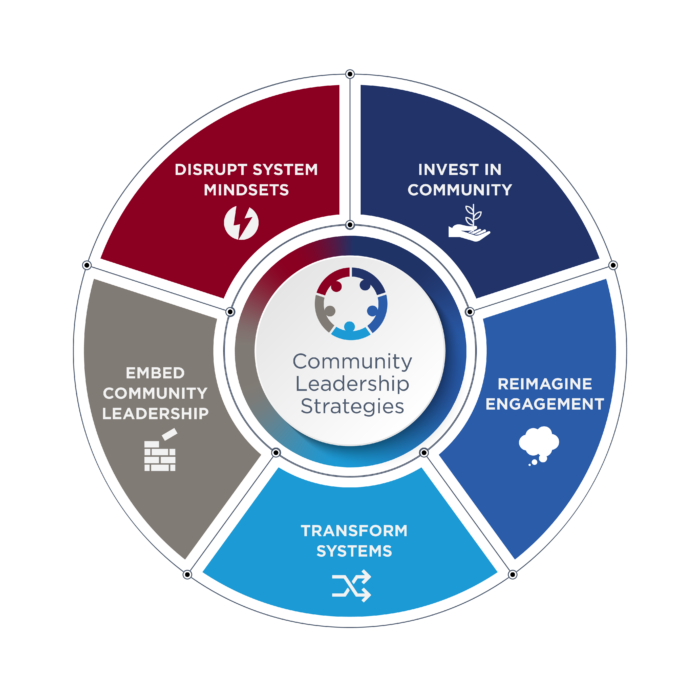System Transformation Through Community Leadership
Strategies for building effective partnerships with Black and Brown communities

What can we learn from past efforts to embed community leadership in public systems change?
Driven by a heightened awareness of systemic inequities, public systems are increasingly working to involve community stakeholders in policy and system planning. The systemic changes necessary to foster thriving in communities of color will never result from institutional efforts alone. When communities bring their skills, insights, and experiences to the table, they can open the door to more transformative and antiracist ways of working. To better drive and promote these new approaches, an interdisciplinary team at Chapin Hall conducted research, explored past projects, and talked with experts from the field to understand what has and hasn’t worked in efforts to build and embed Black and Brown community leadership into public systems change.
Chapin Hall conducted a systematic literature review, examined case studies, and held two focus groups with those active in this space. We learned that business-as-usual practices stymied partnerships when they came up against short timelines and conventional measures of progress, indicating a need to shift toward a long-term, holistic view of impacts. Further, community partners were most able to participate when they were engaged early, had opportunities to build skills relevant to the partnership effort, were able to leverage system resources for community solutions, and there was genuine shared leadership and decision making.
Strategies for system leaders
Chapin Hall has compiled key findings into five system transformation equity bulletins and a toolkit to make lessons from the research accessible to the field, and to promote testing and evaluation of key strategies. The Methods Report, a companion to the five equity bulletins and toolkit, describes the approach and methods used to develop strategies and identify supporting resources. The methods included literature searches, subject matter expert interviews, and case study reviews.
These bulletins are designed for practical use, as systems work to place equity at the center of community partnerships. They do not describe a step-by-step or sequential process. Instead, these strategies could be applied at any stage in a partnership effort.

- Disrupt system mindsets and habits: Reflect on the impact of racism, reinforce strength-based narratives, take the long view when setting milestones.
- Invest in communities: Position communities to take the lead and cultivate community strengths and skills.
- Reimagine community engagement: Prioritize community relationships and trust, expand the decision-making table, and create substantial engagement opportunities.
- Transform systems with community in the lead: Establish community ownership over system responses and resources and then scale up.
- Embed community leadership and adapt over time: Build collaborative infrastructure and commit to continuous evaluation.
- Toolkit: An array of highly actionable resources culled from the field to activate leadership in system change.
- Methods Report: A companion to the five equity bulletins and toolkit, describes the approach and methods used to develop strategies and identify supporting resources.
We encourage systems to go beyond inclusion and community involvement toward community ownership. In this way, systems can play a role in strengthening community members’ capacity to care for one another, solve shared challenges, and determine their own futures.
Contact us
This work was led by an interdisciplinary team including Shannon Kugley, Mallory VanMeeter, Mark McDaniel, and Elizabeth Dierksheide. The work was made possible by Chapin Hall’s Impact Area Funds, a key strategic lever in Chapin Hall’s efforts to become an anti-racist organization and seed new learning for the organization and its partners as we engage in system transformation efforts across the country.
We were inspired by the pioneering work we examined and emboldened to imagine new solutions for how systems can support child and family thriving. But the persistence of inequity means we need to be honest about our results and approaches to date, dig deeper, invest differently, elevate and celebrate family- and community-led solutions, and ultimately cede control of the resources necessary for communities to grow and thrive.
For more information about this work, contact CommunityLeadership@chapinhall.org
Bulletins
Disrupt equity bulletin Invest equity bulletin Reimagine equity bulletinTransform equity bulletin Embed equity bulletin Toolkit
Methods report
 Thank you for your interest in Chapin Hall’s research. Please share some information to access this file.
Thank you for your interest in Chapin Hall’s research. Please share some information to access this file.